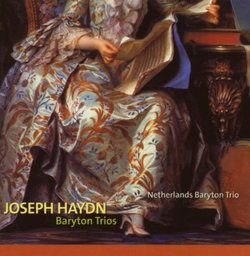| All Artists: Haydn, Borstlap, Tongeren, Insinger Title: Music for Baryton Trio 71 in a Major Members Wishing: 0 Total Copies: 0 Label: Etcetera Original Release Date: 1/1/2008 Re-Release Date: 5/27/2008 Album Type: Import Genre: Classical Styles: Chamber Music, Historical Periods, Classical (c.1770-1830) Number of Discs: 1 SwapaCD Credits: 1 UPC: 8711801101354 |
Search - Haydn, Borstlap, Tongeren :: Music for Baryton Trio 71 in a Major
CD Details |
CD ReviewsNot a Bad Life! Giordano Bruno | Wherever I am, I am. | 01/13/2009 (5 out of 5 stars) "Nikolaus Esterhazy (1714-1790) had something of a distinguished military career, serving the Austro-Hungarian Empire during the 'Seven Years' War', notably at the Battle of Kolin. He didn't relish life in the imperial capital of Vienna, however, and spent most of his time at his hunting lodge in Hungary. A younger brother, he was nonetheless extremely wealthy and able to indulge his tastes in extravagant clothing and architecture. Upon the death of his brother in 1762, he inherited an income from estates larger than the Hapsburg Emperor's, along with the title of Prince. He also inherited the 'employment' of his brother's liveried servants, including one who became rather well-known in later years. In 1766, Prince Nick began construction of a magnificent palace on the site of his old lodge in Hungary, where as the years passed he spent more and more of his time. He was not idle there. He managed his estates, amounting the lands the size of a county in Texas or southern California. He instituted a program of social welfare for his employees and his peasantry, including two small hospitals. Above all, he practiced his music. Music was apparently his governing passion. He was a competent player of the cello, the viola da gamba, and the baryton, his preferred instrument.
The proverbial 'wheel of fortune' didn't turn fast enough to bring any reversal of Esterhazy's magnificence. The saddest incident in his long life life was the death of his wife in 1790; he survived her only a few months. Though he had, by careful management, significantly increased the wealth of his family, his expenses had always been more than proportionate to his income, so that his son Anton found need to retrench upon inheritance. Among Nicholas's expenses were the maintenance of a well-paid palace orchestra - as many as 24 players - and the staging of hundreds of opera performances for private audiences. The 'baryton' is essentially an extended viol da gamba, equipped with 'sympathetic' strings like the viola d'amore, and with several extra bass strings under the neck, to be plucked with the thumb of the left hand while the fingers are placed on the frets. It was a difficult instrument, played chiefly by musical aristocrats, and it would be one of the rarest of musical oddities if it were not for Esterhazy, whose passion for it resulted in the composition of dozens of masterpieces of chamber music. The now-famous employee whom Esterhazy inherited from his brother was Franz Joseph Haydn, quite recently hired as assistant Kapellmeister. Nicholas immediately demanded that his musical servant provide him with suitable works for the baryton; after a bit of ill feeling, Haydn complied, and in 1766 the Prince appointed him Kapellmeister, the position Haydn held for 24 years. By no means was Haydn unappreciated or disrespected; no composer of his era had greater privileges in terms of being able to compose at will and to perform his music with ample, competent instrumentalists and singers. Frankly, Haydn didn't have a bad life either. You might say he was "a pig in clover." In the 1760s and 1770s, Haydn wrote no less than 126 trios for baryton, cello, and viola, plus various other works for chamber ensembles including baryton. That's more music altogether than he wrote for any other ensemble, including string quartets and symphonies. The baryton trios have long been Haydn's least-often performed masterworks. Esterhazy must have been a sensitive and capable player, but no virtuoso. He of course played the baryton in the trios, while the orchestra cellist of the moment played cello, and Haydn himself played viola. The baryton parts are of modest difficulty - probably calibrated exactly to Esterhazy's skills - with little recourse to the plucked-string bass. The cello parts match the baryton in conversational intimacy. The viola parts are rudimentary, scarcely more than harmonizing discant; Haydn was puposeful in allowing his Prince to excel. But virtuosity is not the only form of musical brilliance. The baryton trios are wonderfully inventive and melodic, truly among Haydn's most characteristic compositions, always gracious, never pompous. It was no form of class-torture for Haydn to write them, or to perform them, you may rest assured. We should all experience such benign servitude! This recording by the Netherlands Baryton Trio is the best selection and the most convincing performance of the Haydn trios that I've heard. The baryton does NOT sound like an overweight cello here. Its timbre is distinctly 'silvery' - closer to the viol da gamba - but grandly authoritative. There is never a passage where the cello and the baryton could be confused, even when they are tossing phrases back and forth in playful imitation. The sparing use of the thumb-notes is distinctive and musically effective. Other ensembles have attempted these pieces with two cellos, or in transposition with cello, viola and violin, but the results are not satisfactory. Haydn knew his business; these are BARYTON trios in every detail. If you enjoy Haydn's string quartets, it's hard to imagine that you won't be ecstatic about this performance." |

